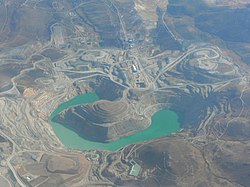Natural resource
Natural resource is any product of nature, material or energetic, that serves to cover the biological needs of the human being (food, clothing, housing, buildings), to develop an economic activity, or well to meet social demands (consumer items).
Economically, resources are considered to be all those means that contribute to the production and distribution of goods and services used by human beings. Economists understand that various types of resources are scarce in the face of the breadth and diversity of human desires, which is how they explain needs. Subsequently, economics is defined as the science that studies the laws that govern the distribution of these resources among the different possible purposes. From this point of view, natural resources refer to the factors of production provided by nature without prior modification by humans; and they differ from cultural and human resources in that they are not generated by humans (such as goods used in industrial transformation (such as heavy industry or agricultural industry, work or technology). The use of any natural resource it entails two concepts to take into account: resistance, which must be overcome to achieve exploitation, and interdependence.
Types of resources and their uses
According to the availability in time, rate of generation (or regeneration) and rhythm of use or consumption, natural resources are classified as renewable and non-renewable. Renewable natural resources refer to biotic resources, resources with cycles of regeneration above its extraction level. Excessive use of them can turn them into extinct resources (forests, fisheries, etc.), although many of them are unlimited (sunlight, tides, winds, among others...). Non-renewable natural resources, for their part, are generally limited deposits or with regeneration cycles well below the rates of extraction or exploitation (mining, oil, etc.). Sometimes it is the abusive and uncontrolled use that makes them exhausted, as for example in the case of the extinction of species. Another phenomenon may be that the resource exists, but cannot be used, as happens with contaminated water, etc.
The consumption of resources is associated with the production of waste: the more resources are consumed, the more waste is generated. It is estimated that in Spain each citizen generates more than 1.38 kg of garbage per day, which at the end of the year represents more than 500 kg of waste.
Renewable Resources
They are those resources that are not depleted with their use, since they return to their original state or are regenerated at a higher rate than the resources decrease through their use. This means that certain renewable resources can cease to be renewable if its use rate is so high that it avoids its renewal, in this sense, rational and intelligent use must be made that allows the sustainability of said resources. Within this category of renewable resources we find water and biomass (every living being).
Some are: wind, solar radiation, hydraulic energy, geothermal energy, wood, and agricultural products such as cereals, fruit trees, tubers, vegetables, waste from agricultural activities among others. (A renewable resource it is a natural resource that can be restored by natural processes at a rate greater than human consumption Solar radiation, tidal, wind and hydroelectric power are resources perpetual that are not in danger of running out in the long term).
Non-renewable resources
Non-renewable resources are natural resources that cannot be produced, cultivated, regenerated, or reused on a scale that can sustain their rate of consumption. These resources often exist in fixed quantities since nature cannot recreate them in periods of time. short geological
The contingents of resources that can be profitably extracted are called reserves. The economic (monetary) value depends on its scarcity and demand and is the issue that concerns the economy. Their usefulness as resources depends on their applicability, but also on the economic cost and energy cost of their location and exploitation.
Some of the non-renewable resources are: coal, oil, minerals, metals, natural gas and groundwater deposits, in the case of confined aquifers without recharge.
Reserve accounting is widely disputed, with the most optimistic estimates by companies, and the most pessimistic by environmental groups and academic scientists. Where the confrontation is most visible is in the field of hydrocarbon reserves. Here the former tend to present as reserves all known deposits plus those they expect to find. The latter emphasize the increasing monetary cost of exploration and extraction, with only one new barrel found for every four consumed, and the increasing thermodynamic (energetic) cost, which decreases the average use value of new discoveries..
Protection
Conservation biology is the scientific study of nature and the state of Earth's biodiversity with the goal of protecting species, their habitats, and ecosystems to prevent excessive extinction rates. It is an interdisciplinary subject of natural resource management sciences, economics, and practice. The term conservation biology was introduced as the title of a conference held at the University of California San Diego in La Jolla, California in 1978 organized by biologists Bruce Wilcox and Michael Soulé.
Habitat conservation is the land resource management system, a practice that seeks to conserve, protect, and restore the habitats of wild plants and animals to prevent their extinction, habitat fragmentation, and reduction of geographic distribution.
Contenido relacionado
Overdraft
Creative Commons
National parks of England and Wales



